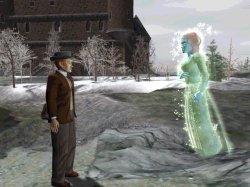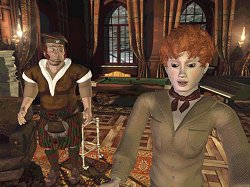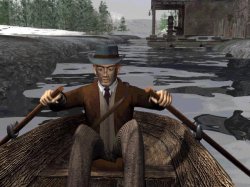|
The Cameron Files: Secret at Loch Ness
 What's a nice, mild-mannered Private Investigator from Chicago doing talking to a Banshee and investigating a Scottish mystery in the 1930s? Well, it seems that genes aren't all that Alan Parker Cameron inherited from his Scottish ancestors.
The introduction shows Cameron relaxing, feet on desk, in his Chicago office reminiscing about his recent trip to Scotland. It succinctly provides information about Cameron's background, his links to Loch Ness and the mystery he uncovered and gives a teasing glimpse of some of the characters he met and the challenges he overcame. Cameron reveals that he received a telegram from Lord Alistair MacFarley of Devil's Ridge Manor asking him, as the son of Sean Cameron, to return to Scotland and to bring his crystal with him. What's a nice, mild-mannered Private Investigator from Chicago doing talking to a Banshee and investigating a Scottish mystery in the 1930s? Well, it seems that genes aren't all that Alan Parker Cameron inherited from his Scottish ancestors.
The introduction shows Cameron relaxing, feet on desk, in his Chicago office reminiscing about his recent trip to Scotland. It succinctly provides information about Cameron's background, his links to Loch Ness and the mystery he uncovered and gives a teasing glimpse of some of the characters he met and the challenges he overcame. Cameron reveals that he received a telegram from Lord Alistair MacFarley of Devil's Ridge Manor asking him, as the son of Sean Cameron, to return to Scotland and to bring his crystal with him.
As you start the game a taxi drops you at the front of the imposing manor in the depths of a bleak Scottish winter. The door is opened by Mr Shastra who ushers you into a large drawing room and leaves you to your own devices. Before you can look around properly Lady MacFarley enters and you introduce yourself. She tells you that you are too late. Lord MacFarley has disappeared.
Now you are on your own again and will remain so for much of the game. The sparse character interaction takes place in cut sequences where you don't need to worry about conversation threads because there aren't any. Nor are there any subtitles, which is a pity as I feel that all adventure games should provide that option so that you don't miss any clues.
 Like most of the games from the Wanadoo stable this is a first person perspective, mouse-controlled adventure where solitary exploration and investigation are paramount. The inside of the manor is richly detailed depicting a proud history yet away from the main floors there is also evidence of decay and neglect. The graphics are very good, particularly during the cut scenes and the sound effects of creaking floorboards and the moaning of the wind all add to the atmosphere. Though I thought this was a little overdone in Cameron's room which sounded like an old sailing ship in rough weather. Because sounds do sometimes provide important clues in this game I wasted much time trying to discover the source of the creaking. Like most of the games from the Wanadoo stable this is a first person perspective, mouse-controlled adventure where solitary exploration and investigation are paramount. The inside of the manor is richly detailed depicting a proud history yet away from the main floors there is also evidence of decay and neglect. The graphics are very good, particularly during the cut scenes and the sound effects of creaking floorboards and the moaning of the wind all add to the atmosphere. Though I thought this was a little overdone in Cameron's room which sounded like an old sailing ship in rough weather. Because sounds do sometimes provide important clues in this game I wasted much time trying to discover the source of the creaking.
The puzzles fit logically within the context of the game and mainly involve using inventory items at the correct location. Though there are one or two leaps of logic, or at least gaps in the narration, as there didn't seem to be enough feedback at times. For example, I am not completely sure why the appearance of 'Nessie' caused something to happen a mile away, or why I should know to go and look for it. Still, I may have missed the clue and on this occasion Alan Parker Cameron seemed to know what was going on even if I didn't.
The puzzle complexity increases as you progress which makes Loch Ness a very easy game to get into, but provides more of a challenge as the mystery deepens. There are a few timed sequences that are not too difficult to overcome with the possible exception of the timed underwater maze. "Arrgh!" I can hear you saying and that was also my first reaction. However, the timed part is only on the way back and after my first failure I mapped and rehearsed my escape route a couple of times before restoring and initiating the timed sequence.
 Another timing aspect occurs throughout the game in that certain actions are not possible until the story has progressed so that a location you fruitlessly searched on one day may allow you to do something on another day. Unfortunately, this is not always indicated at the time by the appearance of a hotspot so you can't say, "ah ah, I will need to come back here later". So if you are stuck you may need to resort to investigating areas you have previously searched to see if anything has changed. Another timing aspect occurs throughout the game in that certain actions are not possible until the story has progressed so that a location you fruitlessly searched on one day may allow you to do something on another day. Unfortunately, this is not always indicated at the time by the appearance of a hotspot so you can't say, "ah ah, I will need to come back here later". So if you are stuck you may need to resort to investigating areas you have previously searched to see if anything has changed.
A click of the right mouse button will open your inventory where you can select items and even combine some of them. From here you can also access Cameron's notebook which will likely provide a clue if you are completely stuck and his wallet where he keeps important papers and even books. A third item, a map of the area, is also added to the inventory once you find it. This is useful for instant travel to selected outdoor locations you have previously visited, but you won't be able to use it all the time -- only if you have access to the outside. Understandably, you cannot use it to escape from a locked room.
Navigation is generally fairly easy as the cursor changes to an arrow to indicate areas that you can move to. The cursor is of the 'floating' variety so that the room revolves as you move it, which I know, makes some players feel queasy. If you have played Wanadoo's earlier games like Dracula Resurrection and The Last Sanctuary you will know what to expect.
Loch Ness comes on two CDs and only allows for a small install. You will be prompted to insert the second disk when you have done everything on the first so there is no constant disk swapping during the game. Unfortunately, when you have moved on to the second disk and you want to re-enter the game you must always start with the first disk in the drive. This is a petty annoyance that should be easy for the developers to overcome, along with the option to enable subtitles.
Overall, though, Loch Ness is an enjoyable game despite my few criticisms. The inclusion of some quite pointed hints in the notebook make it a good choice for novices though experienced players might want to use it sparingly. The story is intriguing and lighthearted with an amiable main character. I enjoyed exploring the lonely old manor and its stark surroundings on the shores of Loch Ness. It's a suitably haunting setting for an ancient mystery with links to a more contemporary one. And, of course, there is 'Nessie' and I have a photo to prove it.
Copyright © Gordon Aplin 2001.
All rights reserved.
System Requirements:
166 Mhz Pentium PC (200 Mhz recommended)
Windows 95/98/Me/XP
16MB RAM (32MB with Win98)
16-bit sound card
16x CD ROM (24x recommended)
|

